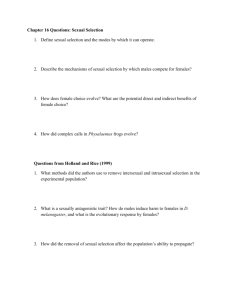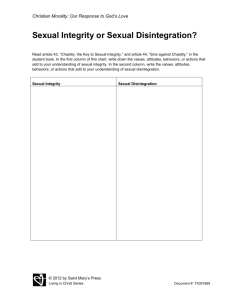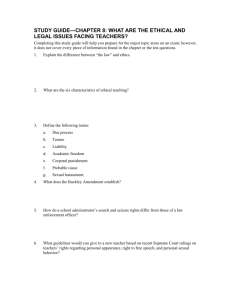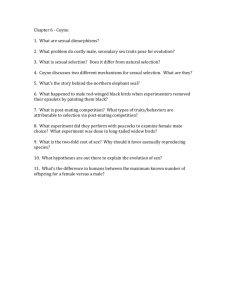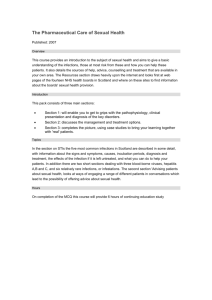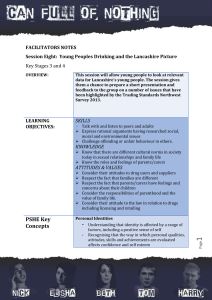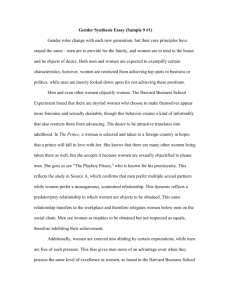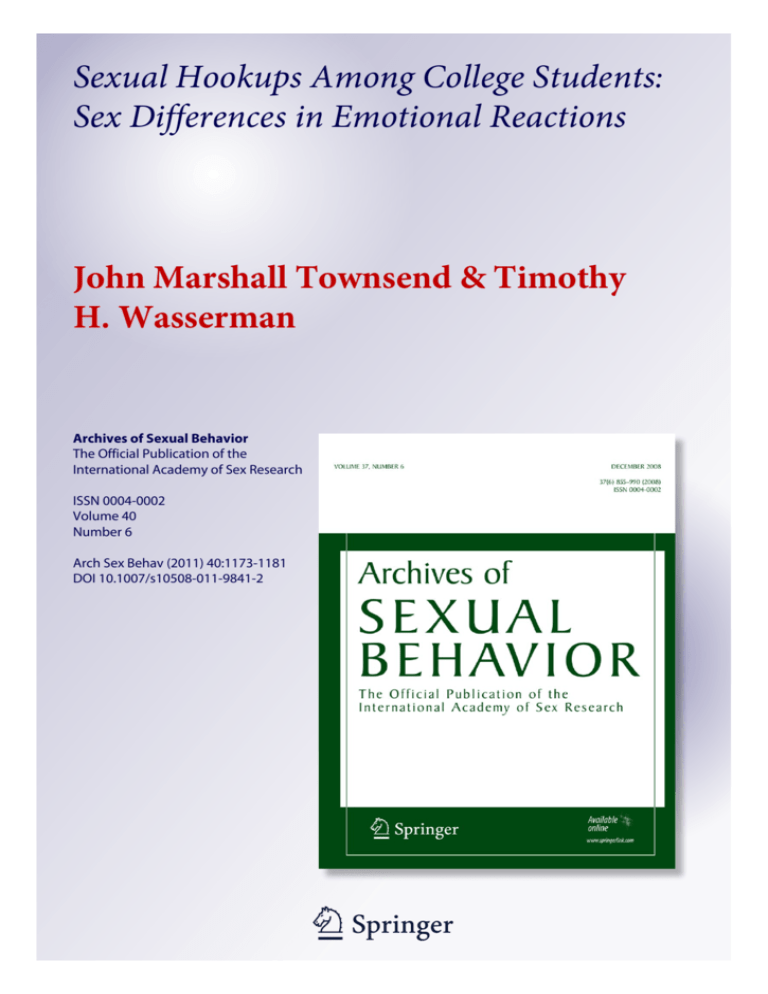
Sexual Hookups Among College Students:
Sex Differences in Emotional Reactions
John Marshall Townsend & Timothy
H. Wasserman
Archives of Sexual Behavior
The Official Publication of the
International Academy of Sex Research
ISSN 0004-0002
Volume 40
Number 6
Arch Sex Behav (2011) 40:1173-1181
DOI 10.1007/s10508-011-9841-2
1 23
Your article is protected by copyright and
all rights are held exclusively by Springer
Science+Business Media, LLC. This e-offprint
is for personal use only and shall not be selfarchived in electronic repositories. If you
wish to self-archive your work, please use the
accepted author’s version for posting to your
own website or your institution’s repository.
You may further deposit the accepted author’s
version on a funder’s repository at a funder’s
request, provided it is not made publicly
available until 12 months after publication.
1 23
Author's personal copy
Arch Sex Behav (2011) 40:1173–1181
DOI 10.1007/s10508-011-9841-2
ORIGINAL PAPER
Sexual Hookups Among College Students: Sex Differences
in Emotional Reactions
John Marshall Townsend • Timothy H. Wasserman
Published online: 6 October 2011
Springer Science+Business Media, LLC 2011
Abstract The purpose of the study was to test four predictions
derivedfrom evolutionary (sexual strategies)theory.Thecentral
hypothesis wasthat menand womenpossessdifferent emotional
mechanisms that motivate and evaluate sexual activities. Consequently, even when women express indifference to emotional
involvement and commitment and voluntarily engage in casual
sexual relations, their goals, their feelings about the experience,
andtheassociationsbetweentheirsexual behaviorandprospects
for long-term investment differ significantly from those of men.
Women’s sexual behavior is associated with their perception of
investment potential: long-term, short-term, and partners’ abilityandwillingnesstoinvest.Formen,theseassociationsareweaker
or inversed. Regression analyses of survey data from 333 male and
363 female college students revealed the following: Greater permissivenessofsexualattitudeswaspositivelyassociatedwithnumber of sex partners; this association was not moderated by sex of
subject (Prediction 1); even when women deliberately engaged in
casual sexual relations, thoughts that expressed worry and vulnerability crossed their minds; for females, greater number of partnerswasassociatedwithincreasedworry-vulnerabilitywhereasfor
males the trend was the opposite (Prediction 2); with increasing
numbers of sex partners, marital thoughts decreased; this finding
was not moderated by sex of subject; this finding did not support
Prediction3;forbothmalesandfemales,greaternumberofpartners
was relatedtolargernumbers ofone-night stands,partnersforeseen
in the next 5 years, and deliberately casual sexual relations. This
J. M. Townsend (&)
Department of Anthropology, Syracuse University, Syracuse,
NY 13244-1090, USA
e-mail: jmtsu44@aol.com
T. H. Wasserman
Office of Institutional Research and Assessment, Syracuse
University, Syracuse, NY, USA
trend was significantly stronger for males than for females (Prediction 4).
Keywords
Emotions
Sexuality Evolution Sex differences Introduction
Researchers have consistently identified the following sex differences in sexuality and partner selection. Male sexuality is
more focused on the genitalia and orgasm, and men are more
willing to engage in sexual relations in the absence of emotional
involvement and marital potential and more likely to seek sexual
relations with a variety of partners (Buss, 1995; Kinsey, Pomeroy, Martin, & Gebhard, 1953; Schmitt, 2005). Men place more
emphasis than women on physical attractiveness in choosing
partnersforsex ormarriage,andwomenplacemoreemphasison
partners’ socioeconomic status (SES) (Buss, 1989a). These sex
differences appear to be universal (Schmitt, 2005).
Schmitt (2005) used the Sociosexual Orientation Inventory
(SOI) to study sexual attitudes and behavior in 48 nations. The
results indicated that, in harsher environments, where women
are more economically dependent on men, women move toward
monogamy whereas men remain relatively promiscuous. Sex
differences in sexual attitudes and behavior are, therefore, larger
in environments that are harsh and lack gender equality. In less
demanding environments, where women enjoy greater economic independence, sex differencesin sexual attitudes and behavior are smaller. .As predicted by evolutionary theory, although sex
differences are attenuated in modern Western nations, they remain
consistently significant (Buss, 1995; Schmitt, 2005).
Consistent with Schmitt’s (2005) findings, recent research
indicates that a growing number of young people in North
America engage in casual sexual encounters known as hookups
123
Author's personal copy
1174
(Grello, Welsh, & Harper, 2006; Owen, Rhoades, Stanley, &
Fincham, 2010; Paul & Hayes, 2002). Although the reported
incidenceofhook-upsvaries, studies consistently report frequencies of 40–80% (Garcia & Reiber, 2008; Grello, Welsh, Harper,
& Dixon, 2003; Owen & Fincham, 2011; Paul, McManus, &
Hayes, 2000).
Sexual Strategies and Emotions
Evolutionary psychologists propose that the sexes’ different
reproductive risks, constraints, and opportunities caused them to
evolve differential strategies to solve reproductive problems
(Buss & Schmitt, 1993). Emotions play a crucial role in human
sexual strategies (Buss, 1989b; Symons, 1979). Over the past
several million years, human females evolved emotional-perceptual mechanisms that cause them to be attracted by partners’
ability and willingness to invest, evaluate the quality of investment, and detect and counteract shirking and false advertising.
Human male mechanisms include the capacity to dissociate sexual pleasure from investment and a desire for a variety of sex
partners who exhibit signs of fertility (Bailey, Gaulin, Agyei, &
Gladue, 1994). By their very nature, male and female strategies
often conflict and interfere with each other; these conflicts represent strategic interference. Over eons men and women evolved
emotional-motivational mechanisms that alert them to strategic
interference and allow them to alter their own behavior and
influence the behavior of the opposite sex to eliminate or reduce
the interference (Buss, 1989b, 1994a). The concepts of‘‘sexual
strategies’’ and ‘‘solutions to adaptive problems’’ do not imply
that the strategies or problems they solve are consciously articulated. Rather, they operate as desires, attractions, and gut-level
emotionsthatdirectandmotivateaction(Buss&Schmitt,1993).
In casual sexual encounters, males and females overlap substantially in their stated motivations, sexual attitudes, and partner-selection criteria (Garcia & Reiber, 2008; Kenrick, Groth,
Trost, & Sadalla, 1993; Owen, Fincham, & Moore, 2011).
Nevertheless,females’greaterconcernregardingthequalityand
duration of investment emerges despite their endorsement of
permissive sexual attitudes and behavior. Garcia and Reiber
(2008) found an equal percentage of males and females mentioned sexual gratification and the possibility of starting romanticrelationshipsasreasonsforhookingup. However,maleswere
more likely to have sex with mere acquaintances and strangers
and hope for more hook-ups in the future; females were more
likely to hook-up with known persons and romantic partners and
hope for traditional romantic relationships. Similarly, in Owen
and Fincham (2011), females were more likely than males to
hope that their hookups would become committed relationships.
Evolutionary psychologists argue that women’s thoughts and
fantasies about romance, marriage, and children indicate concern about and desire for long-term male investment (Buss &
Schmitt, 1993; Ellis & Symons, 1990). Townsend (1995, 1998)
reported that even in initial sexual encounters females had more
123
Arch Sex Behav (2011) 40:1173–1181
romantic thoughts than males did. For females, the reported
incidence of these thoughts did not decline with greater numbers
of sex partners, whereas for males it did decline.
Emotional Reactions to Hookups
With few exceptions, research indicates that females’ reactions
to sexual hookups tend to be negative, whereas males’ reactions
tend to be positive. Simpson (1987) found that sexually permissive women experienced more intense and prolonged emotional distress following dissolution than less permissive women
and more permissive and less permissive men. Townsend (1987,
1995,1998)reportedthatconcernregardingqualityandduration
of investment emerged even in women who expressed complete
acceptance of casual sex. Wondering after an encounter whether
a man would call, whether he cared at all or just wanted sex,
whether she would ever see him again, and if she did, whether he
would even remember her, all signaled concern about investment.
Consistent with this characterization, Paul and Hayes (2002)
found that, for women,‘‘not knowing their partner and the lack of
further contact with the partner seemed to compound their regret
and anger at themselves’’(p. 655). Common negative experiences
for males were the partner was insufficiently attractive and/or
was too promiscuous; common themes for females were shame,
regret, self-blame, and felt-pressure to perform unwanted sex
acts (Paul & Hayes, 2002). Similarly, Glenn and Marquardt
(2001) found that after hooking up, many women felt hurt and
confused about their future relations with their partners. In
Grello et al. (2006), men with more casual partners had fewer
depressive symptoms, whereas women with more casual partners had more depressive symptoms. Fielder and Carey (2010)
also found that penetrative hookups correlated positively with
psychological distress for females, but inversely for males.
Owen et al. (2010) and Owen and Fincham (2011) reported that
males had more positive reactions to hookups than did females
(although females’ reactions were generally positive). In a onesemester prospective study, Owen et al. (2011) found that penetrative hookups were associated with less distress and loneliness for participants who began the semester with greater distress and loneliness. Participants who began the semester with
less distress and loneliness reported an increase in these symptoms at the end of the semester if they engaged in penetrative
hookups. Owen et al. concluded that for some young people
hookups can provide a positive experience and actually improve
psychological well-being—at least in the short term.
Consistent with Owen et al. (2011), Townsend (1987, 1995,
1998) found that women did not necessarily react to casual sexual relations negatively, and some women found them enjoyable. As long as a man appeared willing to invest at the level the
woman felt appropriate at the moment, she felt in control, and
feelings of worry, vulnerability and exploitation did not emerge.
However, females’ concern regarding investment did not decline
with greater numbers of partners whereas men’s concern did
Author's personal copy
Arch Sex Behav (2011) 40:1173–1181
decline, and even very permissive women experienced disturbing emotional reactions when they attempted to maintain sexual relationships that involved insufficient investment (Townsend 1987, 1995, 1998). Qualitative studies of women’s evaluations of hookups are consistent with this interpretation (Glenn
& Marquardt, 2001; Paul & Hayes, 2002).
Gangestad and Simpson (2000) argued that female sexuality
facultatively shifts in demanding environments, and women
become more restricted. Virtually all men desire a variety of sex
partners (Bailey et al., 1994; Kinsey et al., 1953), but when most
women require investment with sex, only the most attractive
heterosexual men (socially dominant,geneticallyfit)canengage
in low-investment copulations (Gangestad & Simpson, 2000;
Townsend, 1993, 1995). Schmitt’s 48-nation study (2005) supportedthisview,andsexualhookupsamongcollegestudentsprovide ample support as well. Given the permissiveness of many
female college students, attractive male students enjoy unprecedented opportunity to fulfill their desire for a variety of physically attractive sexual partners (Garcia & Reiber, 2008; Grello
et al., 2006; Townsend, 1993, 1998).
The Current Study
The goals of the current study were to discover how many
deliberate casual partners subjects had had, and analyze intercorrelations among subjects’ number of sex partners, sexual
attitudes, and how they felt about their casual sexual relations.
We hypothesized the following: the fundamental sexual desires
that motivate action and the emotional reactions that evaluate
these actions differ in men and women. These desires and emotions exist in a feedback system so that even if men and women
express identical sexual attitudes and goals, they nevertheless
are motivated to engage in different types of activities, and their
emotional react ions to the same activities (e.g., casual sexual
relations) differ significantly.
Predictions
On measures such as the SOI, permissive sexual attitudes are
reflected incorrespondinglypermissive sexual behaviorforboth
males and females (Paul et al., 2000; Schmitt, 2005; Simpson &
Gangestad, 1991).
Prediction 1: For both sexes, permissiveness of sexual attitudeswillbepositivelyassociatedwithgreaternumbersofsex
partners. In contrast to conventional measures of sexual attitudes, the thoughts and feelings that concern investment, and
the emotions that occur in response to actual sexual relations
are proximate mechanisms that alert women to strategic interference and guide them toward relationships that offer higher
levels of investment. Number of sex partners should therefore associate differentially with males’ and females’ feelings
concerning investment.
1175
Prediction 2: With increasing numbers of sex partners,
females will experience more vulnerability and worry regarding investment whereas males will experience less worryvulnerability; the gender 9 total number of sex partners interaction term will be significant. Females typically think about
romance, marriage, and children more than do males; these
thoughts indicate concern about and desire for long-termmale
investment (Ellis & Symons, 1990; Townsend, 1998). In shortterm relationships, concern about long-term investment is
reduced for both sexes, but this reduction is stronger for
males than for females (Buss & Schmitt, 1993).
Prediction 3: With increasing numbers of partners, the
incidence of marital thoughts will decline for males more than
for females; the gender 9 total number of sex partners interaction for marital thoughts will be significant. Compared to
women, men report larger numbers of one-night stands, partners in the last year, and deliberately casual partners (Gangestad
& Simpson, 2000; Schmitt, 2005).
Prediction 4: If the fundamental sexual desires that motivate
action, and the emotional reactions that evaluate these actions
differ as proposed, it is predicted that with increasing numbers
of sex partners, those sexual behaviors that involve minimal
investment will increase more for males than for females;
consequently, the gender 9 total number of partners interaction will be significant for casual sexual behaviors.
Method
Participants
The participants were 335 male and 365 female students from
an introductory psychology course at a private, northeastern
university in the U.S. Participants received credit toward the
research participation requirement of the class. All subjects in both
samples were unmarried and between the ages of 18 and 23 years.
University policy dictates that sign-up sheets for experiments be
accompanied by a brief description of the task. Participants thereforereadwhentheysignedupthattheinvestigatorswere‘‘interested
in heterosexual dating and sexual experience.’’To our knowledge,
no participants declined to participate after they signed the consent
form.
Procedure
Participants completed the surveys in same-sex groups of 10–20
under the supervision of like-sex, graduate research assistants.
Participants read and signed a standard consent form that was
approved by the University’s Institutional Review Board. After
participants completed their consent forms, they read the following instructions: ‘‘You are asked to complete a brief questionnaire concerning your choice of partners for different types
123
Author's personal copy
1176
Arch Sex Behav (2011) 40:1173–1181
of relationships. There will also be some background information requested of you. Please answer all questions as honestly as
you can. If you feel a question is not applicable, you may leave it
blank. Remember, all your responses will be kept completely
confidential. There is no way we can identify you with your
responses, and we truly have no interest in doing so. You are now
ready to begin. Please turn to the next page. If at any time you
have a question, raise your hand and we will assist you.’’
for analysis (Cronbach’s alpha = .77):‘‘Even when I’ve first met
a guy/girl, if I have sex with him/her, afterwards, thoughts cross
my mind like: ‘I wonder what it would be like being married to
him/her? What would our wedding be like? Where would we go
on our honeymoon? What would our kids look like?’‘‘ The marital thoughts and worry-vulnerability items were followed by
agree-disagree scales, where 1 = strongly disagree, 5 = undecided, and 9 = strongly agree.
Measures
Casual Sexual Behavior
Sexual Attitudes
We used two of the SOI behavior items (partners in last year and
one-night stands). We did not include‘‘partners foreseen in the
next 5 years’’because it is speculative and does not refer to actual
behavior; the SOI fantasy item was omitted for similar reasons.
An additional question was aggregated with the two SOI behavior questions (Cronbach’s alpha = .83):‘‘Have you ever had sex
with someone, and you knew before you had sex that you did not
want to get emotionally involved with this person; with how
many partners have you done this?’’This item was designed to
identify sexual relations that were deliberately casual, i.e., relations that involved little investment of time and emotion and
were not supposed to lead to a more serious relationship (Townsend, Kline, & Wasserman, 1995).
The SOI normally consists of seven questions: number of sex
partners in the previous year; number of one-night stands; number of sex partners foreseen in the next 5 years; frequency of
sexual fantasies about people other than the current dating partner; and three attitudinal questions:‘‘Sex without love is ok’’;‘‘I
can imagine myself being comfortable and enjoying ‘casual’ sex
with different partners’’;‘‘I would have to be closely attached to
someone (both emotionally and psychologically) before I could
feel comfortable and fully enjoy having sex with her/him.’’The
SOI correlates with numerous measures of sexuality and personality (Gangestad & Simpson, 2000). In the current questionnaire,‘‘havingsex’’and‘‘sexpartner’’weredefinedas:‘‘sexualintercourse, including oral sex.’’
To measure sexual attitudes, we adopted the three attitude
questions from the SOI. A fourth item stated:‘‘I feel I should be
emotionally involvedwith a man/womanbefore havingsex with
him/her.’’ This item’s correlations with other measures of attitudes and behavior were similar to those of the SOI attitude items
(Townsend, 1995); consequently, this item was aggregated with
the three SOI attitude questions (Cronbach’s alpha = .86). The
four attitude items were answered on Likert-type scales, where
1 = strongly disagree, 5 = undecided, and 9 = strongly agree.
Worry-Vulnerability
The following question assessed feelings of concern and vulnerability that occurred in response to repeated sexual relations with a
casual partner: ‘‘Even if I don’t think I want to be emotionally
involved with a person, if I have sex with him/her a few times, I
begin to feel vulnerableandwould at least liketoknow he/shecares
about me.’’This item focused on two aspects of the hypothesized
sexual emotions: the involuntary nature of these feelings (i.e., they
occur regardless of whether the participant wishes to become emotionally involved); that repeated sexual relations with someone are
more likely to elicit these feelings than a single encounter
Marital Thoughts
To assess marital thoughts, the following questions were adopted from previous research (Townsend, 1995) and aggregated
123
Results
To test for gender differences, t-tests were performed on the
items and aggregates; results, along with the effect sizes, appear
in Table 1. To control for gender differences in mean responses
and numbers of sex partners, participants’ responses were subjected to regression analyses, with participant’s gender and total
number of sex partners as independent variables, and responses
to the items and aggregates in Table 1 as dependent variables
(participant’sgenderwasdummycoded: 0 = male; 1 = female).
Regression analyses appear in Table 2.
Sexual Attitudes
Compared to women, men tended to report more permissive
sexual attitudes. For all attitude questions, these gender differences were highly significant; d-values were large and ranged
from .85 to 1.19 (see Table 1). Regression analysis of the sexual
attitudes scale showed that, controlling for number of partners,
males had more permissive attitudes than females (see Table 2).
For both sexes, number of partners was positively associated
with increasingly permissive attitudes; the gender 9 number of
partners interaction was non-significant. Hence, the gender difference in attitudes was not moderated by number of partners.
Controlling for number of partners, males endorsed casual sex
more strongly than females and this gender difference remained
constant. These findings supported Prediction 1.
Author's personal copy
Arch Sex Behav (2011) 40:1173–1181
1177
Table 1 Mean sexual attitudes, worry-vulnerability, marital thoughts, and casual sexual behavior by gender and number of sex partners
Men
Women
M
SD
M
t
SD
d-between
sex
Sexual attitudes
1. Sex without love is ok
5.89
2.36
3.83
2.46
11.40**
0.85
2. Can imagine I enjoy ‘‘casual’’ sex
5.68
2.52
3.02
2.41
14.38**
1.04
3. Need attachment to enjoy sex
4.94
2.57
7.18
2.41
-11.97**
0.90
4. Need emotional involvement before sex
5.12
2.52
7.30
2.13
-12.41**
0.94
21.50
8.13
12.37
7.28
15.94**
1.19
5.57
2.28
6.96
2.22
5.42**
0.61
3.80
2.45
4.65
2.89
2.85*
0.32
Sexual attitudes aggregate
Worry-vulnerability
5. Worry/feel vulnerable if I have repeated casual sex with same partner
Marital thoughts
6. Have romantic/marital thoughts after initial casual sexual encounters
Casual sexual behavior
7. Number of sex partners in the last year
2.44
1.11
2.23
0.92
2.69*
0.21
8. Number of one-night stands
2.17
1.25
1.73
0.86
5.39**
0.41
9. Intentional sexual relations without emotional involvement (number of partners)
2.21
1.31
1.68
0.97
5.88**
0.46
Casual sexual behavior aggregate
6.82
3.26
5.64
2.38
5.85**
0.42
Note: Males, n = 333, females, n = 363. For Questions 1–6, absolute range, 1–9. For Questions 5 and 6, participants who did not engage in these
activities were omitted from analysis (n = 186 males and 134 females). Items 3 and 4 were reverse-scored for creation of the Sexual attitudes
aggregate. d-between sex describes the effect size of gender differences between mean responses; effect sizes of .2 are considered small, .5 are
medium, and .8 are large (Cohen, 1992)
* p\.05, ** p\.0001
Worry-Vulnerability
for females the trend was the opposite. These findings supported
Prediction 2.
Women reported a higher mean level of worry-vulnerability
than men; the effect size was .61, which is considered a mediumlevel effect (Table 1). With number of partners controlled
through regression, this gender difference no longer reached
significance (Table 2). Greater number of partners was associated with decreased worry-vulnerability; however, this effect
was qualified by a significant gender 9 number of partners interaction. For females, greater number of partners was associated
with increased worry-vulnerability. Taken together, the main
effect for number of partners and the gender 9 number of partners interaction showed that for males, greater number of partners was associated with reduced worry-vulnerability whereas
Marital Thoughts
Relative to males, females reported a greater tendency to experience marital thoughts; effect size was .32, a small effect (Table 1).
However, with number of partners controlled via regression analysis, this gender difference was not significant. As number of
partners increased, marital thoughts decreased. This main effect
for number of partners was not qualified by gender, i.e., the
gender 9 number of partners interaction was not significant
(Table 2). These findings did not support Prediction 3.
Table 2 Standardized regression estimates of attitudes, worry-vulnerability, marital thoughts, and casual sexual behavior, by gender and number of
sex partners
Dependent variables
Independent variables
Gender
Sexual attitudes
-0.494***
Number of partners
0.337***
Gender 9 Number of partners
Model F
0.053
128.80***
Worry-vulnerability
0.064
-0.130*
0.259*
11.73***
Marital thoughts
Casual sexual behavior
0.026
0.030
-0.146*
0.93***
0.156
-0.193***
4.66**
661.60***
Males (coded‘‘0’’), n = 333; females (coded‘‘1’’), n = 363. For Worry-vulnerability and Marital Thoughts, only subjects who reported that they had
engaged in those activities were included in analysis (n = 186 males and 134 females)
* p\.05, ** p\.01, *** p\.0001
123
Author's personal copy
1178
Casual Sexual Behavior
Compared to females, males reported more one-night stands,
partners in the last year, and intentional sex without emotional
involvement; effect sizes ranged from .21 to .46, which are small
effects (Table 1). When number of partners was controlled in the
regression analysis, however, the gender difference for casual
sexual behavior failed to reach significance (Table 2).
Predictably, total number of sex partners was highly associated with the casual sexual behavior items, but this main effect
was moderated by a gender 9 total number of partners interaction. Although both sexes reported increased casual sexual
behavior with increased number of partners, compared to males,
the increase for females was significantly smaller (though still in
the positive direction); hence, the gender 9 total number of
partners interaction was significant for casual sexual behavior.
These findings supported Prediction 4.
Discussion
The goals of the current study were to discover how many
deliberate casual partners subjects had had, and analyze intercorrelations among subjects’ number of sex partners, sexual attitudes, and how they felt about theircasual sexual relations. Compared to females, males tended to have more permissive sexual
attitudes. This gender difference was not moderated by number
of partners (Prediction 1). Viewed alternatively, compared to
males, females acquired an equal number of sex partners despite
their less permissive attitudes. Arguably, this occurred because
males tend to be less selective than females in choosing partners
and generally more willing to engage in low-investment copulation (Baumeister, Catanese & Vohs, 2001; Townsend, 1993).
Thisgenderdifferenceremainedconstantdespiteincreasingnumbers of partners.
Compared to men, women were more likely to agree that they
experiencedworry-vulnerabilityevenwhentheyhadnotwanted
emotional involvement. In contrast to our measures of sexual
attitudes, the gender 9 number of partners interaction was significant for worry-vulnerability. Taken together, the main effect
for number of partners and the gender 9 number of partners interaction showed that for males, greater number of partners was
associated with reduced worry-vulnerability, whereas for females
the trend was the opposite (Prediction 2). Prior studies have
reported that penetrative hookups correlated positively with
females’ depressive symptoms and other indices of psychological distress, whereas for males this association was reversed
(Fielder & Carey, 2010; Glenn & Marquardt, 2001; Grello et al.,
2006; Simpson, 1987). Our measures could not determine
whether worry-vulnerability was associated with depressive
symptoms or other types of psychological distress, nor whether
women’s emotional reactions contributed to their lesser interest
and indulgence in casual relations. Nevertheless, the current
123
Arch Sex Behav (2011) 40:1173–1181
findings were certainly consistent with these prior studies and
with this proposition.
With increasing numbers of partners, marital thoughts
declined for both sexes. The gender 9 number of partners interaction was non-significant (Prediction 3), whereas in a prior study
it was significant: with increasing number of partners, the reduction in marital thoughts was greater for males than for females
(Townsend, 1995). Arguably, contemporary females are less likely
than thosein1995 tobelievethat relationshipsbegunincollegewill
end in marriage, and more likely to postpone marriage (Garcia &
Reiber, 2008). The current female tendency to delay marriage may
account for the discrepancy between the current and previous
findings (Townsend, 1995). Contemporary females who engage in
hookups may express desire for romantic or committed relationships rather than for marriage (Garcia & Reiber, 2008; Owen &
Fincham, 2011). In future research the marital-thoughts question
will be reformulated to assess desire for relationships.
Compared to women, men tended to have more sex partners
last year, one-night stands, and deliberate casual partners (casual
sexual behavior). With total number of partners controlled
through regression, the main effect for gender was non-significant. However, this main effect was moderated by a significant
gender by number of partners interaction. Both sexes reported
increased casual sexual behavior with increased number of partners, but this increase was significantly greater for males than for
females (Prediction 4). This finding is consistent with the
proposition that males and females differ in their sexual motivations: compared to females, males are more strongly motivated to copulate with a variety of partners who exhibit the signs
of youth and fertility (Baumeister et al., 2001; Regan & Atkins,
2006; Symons, 1979). Hence, when opportunity allows, the
most attractive males engage in low-investment copulation with
multiple partners, and their number of casual partners increasingly diverges from that of even the most permissive females
because the sexes’ underlying motivations differ. Furthermore,
our male participants’ responses were consistent with previous reports of environmentally-contingent shifts in male preferences, emotions, and behavior (Buss, 1994b; Landolt, Lalumiere,
& Quinsey, 1995; Penke & Denissen, 2008; Waller, 1994). Taken
together, the current findings and these previous studies supported
our general proposition: although the sexes overlap considerably in
their sexual attitudes and behavior, their underlying motivations
differed and they, therefore, differentially utilized sexual opportunities.
Our data cannot determine whether women’s emotional
reactions contribute to their lesser interest and indulgence in
casual relations, nor can they determine whether worry-vulnerability is associated with depressive symptoms and other measures
ofpsychologicaldistress.Nevertheless,itisplausiblethatthistype
of feedback occurs, and the sex differences in worry-vulnerability
that we recorded are part of this sexually dimorphic feedback.
Even in women with very permissive attitudes, concern about the
reliability and adequacy of investment (as expressed in worry,
Author's personal copy
Arch Sex Behav (2011) 40:1173–1181
vulnerability, regret, and shame) serves to evaluate investment
and guard against strategic interference (i.e., sexual relations with
partners who are unwilling or unable to invest sufficiently). Further participation in casual sexual activities increases females’
worryandnegativeemotions;thesenegativefeelingsarereflected
in measures of psychological distress. If this interpretation is correct, men and women tend to receive differential feedback when
they engage in casual sexual relations. For women, their feelings
and memories can be very negative; for men, they are more often
positive, and they stimulate men to attempt to repeat the experience (Fielder & Carey, 2010; Kinsey et al., 1953; Townsend,
1987, 1995).
Owen et al. (2011) concluded that for some young people
hookups can provide a positive experience—at least in the
short term. Consistent with this interpretation, Townsend (1987,
1995, 1998) found that permissive women could sporadically
engage in casual sexual encounters with few negative consequences. Many contemporary women experiment with casual
relations, but most eventually tire of them and gravitate toward
relationshipsthatoffersuperiorlevelsofinvestment(Townsend,
1998). Furthermore, even extremely permissive women experience disturbing emotional reactions when they attempt to
maintain sexual relationships that involve insufficient investment(Townsend,1987,1995,1998).Thesefindingssuggest that
control over level of investment, more than traditional morality,
may determine permissive women’s emotional reactions to
casual sex. Women’s qualitative evaluations of their hookups
areconsistent withthisinterpretation:permissivewomendidnot
appear to reject casual sex per se; rather, they felt upset when
theirpartnersshowedinsufficientinterestinthemandtheirneeds
(Glenn & Marquardt, 2001; Paul & Hayes, 2002). Some factor
causes even permissive women to desire relationships that offer
quality investment, and eventually to be disturbed by relationships that involve inadequate investment. We propose that the
feelings expressed in worry-vulnerability are part of the emotional feedback that limits women’s experiments with casual
relations and guides them toward higher-investment relationships. The current findings were thus consistent with our general
hypothesis: Even when women express indifference to emotional involvement and commitment and voluntarily engage in
casual sexual relations, their hopes and feelings about the experience differ significantly from those of men. Women’s sexual
behavior and their emotional reactions to this behavior are associated with their perception of investment. For men these associations are weaker or reversed.
Limitations
The worry-vulnerability item stated,‘‘…if I have sex with him/
her a few times, I begin to feel vulnerable and would at least like
to know he/she cares about me’’(see Appendix). This formulation implies that participants experience these thoughts every
timetheyengageinthisactivity.Hence,apersonwhoengagedin
1179
thisactivitywithmanypartnerswouldexperiencethesethoughts
more frequently than someone who tried it with fewer partners.
Yet, both of these individuals could mark the same point on the
agree-disagree answer scale and thus appear to experience these
thoughts with the same frequency. The way the item was worded
it was impossible to determine the actual frequency of worryvulnerability thoughts. We plan to address this issue in future
research. Even with this limitation, however, the gender 9 number of partners interaction was significant: for males, greater
number of partners was associated with reduced worry-vulnerability whereas for females the trend was the opposite.
Because our samples were cross-sectional and analysis correlational, we cannot determine causal relationships among the
study variables. Nevertheless, men’s greater willingness to have
sex with attractive partners suggests that most men have sufficient desire to lead to multiple casual encounters if opportunity
allows, and the emotional feedback they receive motivates them
to repeat the experience (Baumeister et al., 2001; Gangestad &
Simpson, 2000; Regan & Atkins, 2006; Schmitt, 2005). We
propose, therefore, that the attitudes, thoughts, and feelings of
men with more experience in casual relations diverge from those
of less experienced men as the former gain familiarity, confidence, and experience. In comparison, women derive a contrary
lesson from casual sexual relations; such relations can be fun
initially, but most women eventually experience them as unfulfilling (if not degrading) and consequently seek higherinvestment relationships. Research among college students and
young professionals supports this characterization of gender
differences (Todd, Penke, Fasolo, & Lenton, 2007; Townsend,
1987; Townsend & Roberts, 1993; Townsend & Wasserman,
1998).
Implications
Conventional measures of sexual attitudes can be poor predictors of behavior (Penke & Asendorpf, 2008), and even more
inadequate in predicting emotional reactions (Townsend, 1995,
2005). Open-ended questions allow participants to express their
feelings in their own words and thus may provide a better window into actual emotional reactions (Glenn & Marquardt, 2001;
Paul&Hayes,2002;Townsendetal.,1995).Similarly,theuseof
clinical instruments that are ostensibly independent of questions
regarding sexual attitudes and behavior may reduce demand
characteristics and thus reveal otherwise hidden associations
between sexual behavior and emotional reactions (Fielder &
Carey, 2010; Grello et al., 2006).
Motivations for sexual encounters present a similar problem.
Townsend (1993, 1998) found that college men’s financial
resources, athletic ability, and expected incomes were positively
associated with number of sex partners. Simply asking women,
however, whether male status influences their partner selection
often elicits denial because this motive is unconscious and/or
socially unacceptable (Townsend, 1998). In contrast, more
123
Author's personal copy
1180
Arch Sex Behav (2011) 40:1173–1181
oblique methods can reveal the effects of male status (van
Straaten, Engels, Finkenauer, & Holland, 2008). Similarly,
appropriate experimental designs as well as forced-choice
and open-ended questions have revealed the powerful, yet sometimes obscure effects of male status and resources on females’
choice of partners—both for short-term and long-term relationships (Buss & Schmitt, 1993; Todd et al., 2007; Townsend,
1989, 2005; Townsend & Levy, 1990; Townsend & Roberts,
1993; Townsend & Wasserman, 1998).
Paul and Hayes (2002) found that students tended to idealize
hook-ups and ignore their negative aspects: ‘‘Especially worrisome was females’ lack of communication about unwanted or
forced sexual involvement’’ (p. 657). Other researchers have
echoed this concern (Lambert, Kahn, & Apple, 2003). This
dearth of communication reifies the popular, positive image of
hook-ups, and produces a vicious cycle of more hook-ups,
regret, and self-blame in women (Paul & Hayes, 2002). The
current findings and literature reviewed suggest that many contemporary women approve, in principle, of casual sexual relations and believe that they will enjoy them. Many, however, will
eventually discover that they do not like casual sex, or at least not
when they lack control of male investment, and this discovery
can be painful. Increasing freedom and opportunities does cause
men and women to overlap in some aspects of their sexual
attitudes and behavior, but it also allows more men, particularly
those with high status, to attempt low-investment copulations,
and more women to feel exploited when they succeed. The doyenne of feminist sociology, Bernard (1972), predicted that the
more freedom men and women enjoy, ‘‘the more fundamental
and ineradicable differences will show up’’ (p. 256). The evidence reviewed here was consistent with her prediction.
Appendix
Question Content
Sexual Attitudes
1.
2.
3.
4.
Sex without love is ok
I can imagine myself being comfortable and enjoying
‘‘casual’’ sex with different partners.
I would have to be closely attached to someone (both emotionally and psychologically) before I could feel comfortable and fully enjoy having sex with him/her.
I feel I should be emotionally involved with a man/woman
before having sex with him/her
Worry-Vulnerability
5.
EvenifIdon’tthinkIwanttobeemotionallyinvolvedwitha
person, if I have sex with him/her a few times, I begin to feel
123
vulnerable and would at least like to know he/she cares
about me.
Marital Thoughts
6.
Even when I’ve first met a guy/girl, if I have sex with him/
her, afterwards, thoughts cross my mind like: I wonder what
it would be like being married to him/her. What would our
wedding be like? Where would we go on our honey-moon?
What would our kids look like?
Casual Sexual Behavior
7.
8.
9.
Number of sex partners in the last year
Number of one-night stands
Have you ever had sex with someone, and you knew
before you had sex that you did not want to get emotionally involved with this person? (number of partners
you have done this with)
References
Bailey,J.M.,Gaulin,S.,Agyei,Y.,&Gladue,B.A.(1994).Effectsofgender
andsexualorientationonevolutionarilyrelevantaspectsofhumanmating psychology. Journal of Personality and Social Psychology, 66,
1081–1093.
Baumeister, R. F., Catanese, K. R., & Vohs, K. D. (2001). Are there gender
differences in strength of sex drive? Theoretical views, conceptual distinctions, and a review of relevant evidence. Personality and Social
Psychology Review, 5, 242–273.
Bernard, J. (1972). The future of marriage. New York: Bantam.
Buss, D. M. (1989a). Sex differences in human mate preferences: Evolutionary hypotheses tested in 37 cultures. Behavioral and Brain Sciences, 12, 1–49.
Buss, D. M. (1989b). Conflict between the sexes: Strategic interference
and the evocation of anger and upset. Journal of Personality and
Social Psychology, 56, 735–747.
Buss, D. M. (1994a). The evolution of desire. New York: Basic Books.
Buss, D. M. (1994b). Individual differences in mating strategies. Behavioral and Brain Sciences, 17, 581–582.
Buss, D. M. (1995). Evolutionary psychology: A new paradigm for
psychological science. Psychological Inquiry, 6, 1–30.
Buss, D. M., & Schmitt, D. P. (1993). Sexual strategies theory: An evolutionary perspective on human mating. Psychological Review, 100,
204–232.
Cohen, J. (1992). A power primer. Psychological Bulletin, 112, 155–159.
Ellis, B. J., & Symons, D. (1990). Sex differences in sexual fantasy: An
evolutionary psychological approach. Journal of Sex Research, 27,
527–555.
Fielder, R. L., & Carey, M. P. (2010). Predictors and consequences of
sexual ‘‘hookups’’ among college students: A short-term perspective study. Archives of Sexual Behavior, 39, 1105–1119.
Gangestad, S. W., & Simpson, J. A. (2000). The evolution of human
mating: Trade-offs and strategic pluralism. Behavioral and Brain
Sciences, 23, 573–644.
Garcia, J. R., & Reiber, C. (2008). Hook-up behavior: A biopsychosocial
perspective.Journalof Social,Evolutionary,andCulturalPsychology,
2, 192–208.
Author's personal copy
Arch Sex Behav (2011) 40:1173–1181
Glenn, N., & Marquardt, E. (2001). Hooking up, hanging out, and hoping for
Mr. Right: College women on dating and mating today. New York:
Institute for American Values.
Grello, C. M., Welsh, D. P., & Harper, M. S. (2006). No strings attached: The
nature of casual sex in college students. Journal of Sex Research, 43,
255–267.
Grello, C. M., Welsh, D. P., Harper, M. S., & Dickson, J. W. (2003).
Dating and sexual relationship trajectories and adolescent functioning. Adolescent and Family Health, 3, 103–112.
Kenrick, D. T., Groth, G., Trost, M. R., & Sadalla, E. K. (1993). Integrating
evolutionaryandsocialexchangeperspectivesonrelationships:Effectsof
gender, self-appraisal, and involvement level on mate selection criteria.
Journal of Personality and Social Psychology, 64, 951–969.
Kinsey, A. C., Pomeroy, W. B., Martin, C. E., & Gebhard, P. H. (1953).
Sexual behavior in the human female. Philadelphia: W. B. Saunders.
Lambert, T. A., Kahn, A. S., & Apple, K. J. (2003). Pluralistic ignorance and
hooking up. Journal of Sex Research, 40, 129–133.
Landolt, M. A., Lalumiere, M. L., & Quinsey, V. L. (1995). Sex differences
inintra-sexvariationsinhumanmatingtactics:Anevolutionaryapproach.
Ethology and Sociobiology, 16, 3–23.
Owen, J., & Fincham, F. D. (2011). Young adults’ emotional reactions after
hooking up encounters. Archives of Sexual Behavior, 40, 321–330.
Owen, J., Fincham, F. D., & Moore, J. (2011). Short-term perspective
study of hooking up among college students. Archives of Sexual
Behavior, 40, 331–341.
Owen, J. J., Rhoades, G. K., Stanley, S. M., & Fincham, F. D. (2010).
‘‘Hooking up’’among college students: Demographic and psychosocial correlates. Archives of Sexual Behavior, 39, 653–663.
Paul, E. L., & Hayes, K. A. (2002). The casualties of‘‘casual’’sex: A qualitativeexplorationofthephenomenologyofcollegestudents’hookups.
Journal of Social and Personal Relationships, 19, 639–661.
Paul, E. L., McManus, B., & Hayes, A. (2000).‘‘Hook-ups’’: Characteristics
and correlates of college students’ spontaneous and anonymous sexual
experiences. Journal of Sex Research, 37, 76–88.
Penke, L., & Asendorpf, J. B. (2008). Beyond global sociosexual
orientations: A more differentiated look at sociosexuality and its
effects on courtship and romantic relationships. Journal of Personality and Social Psychology, 95, 1113–1135.
Penke, L., & Denissen, J. J. A. (2008). Sex differences and lifestyledependent shifts in the attunement of self-esteem to self-perceived
mate value: Hints to an adaptive mechanism? Journal of Research
in Personality, 42, 1123–1129.
Regan, P. C., & Atkins, L. (2006). Sex differences and similarities in frequency and intensity of sexual desire. Social Behavior and Personality,
34, 95–102.
Schmitt, D. P. (2005). Sociosexuality from Argentina to Zimbabwe: A
48-nation study of sex, culture, and strategies of human mating.
Behavioral and Brain Sciences, 28, 247–275.
1181
Simpson, J. A. (1987). The dissolution of romantic relationships:
Factors involved in relationship stability and emotional distress.
Journal of Personality and Social Psychology, 53, 683–692.
Simpson, J. A., & Gangestad, S. W. (1991). Individual differences in
sociosexuality: Evidence for convergent and discriminant validity.
Journal of Personality and Social Psychology, 60, 870–883.
Symons, D. (1979). The evolution of human sexuality. New York: Oxford
University Press.
Todd, P. M., Penke, L., Fasolo, B., & Lenton, A. P. (2007). Different
cognitive processes underlie human mate choices and mate preferences. Proceedings of the National Academy of Sciences USA, 104,
15011–15016.
Townsend, J. M. (1987). Sex differences in sexuality among medical
students: Effects of increasing socioeconomic status. Archives of
Sexual Behavior, 16, 427–446.
Townsend, J. M. (1989). Mate selection: A pilot study. Ethology and
Sociobiology, 10, 241–253.
Townsend, J. M. (1993). Sexuality and partner selection: Sex differences
among college students. Ethology and Sociobiology, 14, 305–330.
Townsend, J. M. (1995). Sex without emotional involvement: An evolutionary interpretation of sex differences. Archives of Sexual Behavior,
24, 171–204.
Townsend, J. M. (1998). What women want—What men want. New
York: Oxford University Press.
Townsend, J. M. (2005). Sex, sex differences, and the new polygyny.
Behavioral and Brain Sciences, 28, 295–296.
Townsend, J. M., Kline, J., & Wasserman, T. H. (1995). Low-investment
copulation: Sex differences in motivations and emotional reactions.
Ethology and Sociobiology, 16, 25–51.
Townsend, J. M., & Levy, G. D. (1990). Effects of potential partners’
costume and physical attractiveness on sexuality and partner selection. Journal of Psychology, 124, 371–389.
Townsend, J. M., & Roberts, L. W. (1993). Gender differences in mate
preference among law students: Divergence and convergence of criteria. Journal of Psychology, 127, 507–528.
Townsend, J. M., & Wasserman, T. H. (1998). Sexual attractiveness: Sex
differences in assessment and criteria.Evolution and Human Behavior,
19, 171–191.
van Straaten, I., Engels, R. C. M. E., Finkenauer, C., & Holland, R. W.
(2008). Sex differences in short-term mate preferences and behavioral
mimicry:Asemi-naturalisticexperiment.ArchivesofSexualBehavior,
37, 902–911.
Waller, N. (1994). Individual differences in age preferences in mates.
Behavioral and Brain Sciences, 17, 578–581.
123

